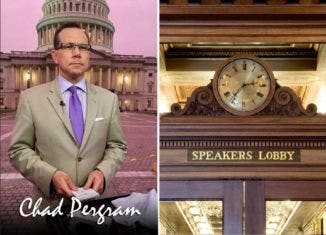A Drop in the Bucket
For his second inauguration on Monday, President Obama will stand beneath the most enduring symbol of American democracy and freedom: the Capitol Dome.
And these days, it’s also a symbol of trouble.
The dome perched atop the U.S Capitol begs for major repairs. Some 1,300 cracks snake across the dome. Workers have removed metal ornaments from the top out of fear they could fall and injure someone. The roof leaks when it rains. And lawmakers struggle to find a way to repair the very dome under which they work.
Seemingly everything is a conflict in Congress these days. There was the battle to resolve the fiscal cliff – with the Senate closing the vote just after 2 am on New Year’s Day. Then there was the titanic and sometimes caustic clash over approving disaster money for victims suffering after Hurricane Sandy.
So why should reaching an accord over the Capitol’s leaky roof be any different.
“The dome needs rehabilitation obviously. It’s an old structure. A beautiful structure. One of the things the nation prides itself on,” said Sen. Chuck Schumer (D-NY), a leading advocate to repair the dome. “Not to fix it would be like not fixing the roof of your house. This is the national house.”
Rep. Mike Honda (D-CA) is the top Democrat on the House panel which controls what lawmakers spend on Congress. Honda says he’d muscle the money through to fix the dome if Democrats controlled the House, making him chair of the Legislative Branch Appropriations Subcommittee. But for now, Honda can only hope for the cardiovascular health of the Capitol’s heart.
“If the inside of the dome were a human body then I could probably say it needs a stent,” said Honda with a chuckle.
Lightning strikes, fierce winds and a bizarre, 5.8 magnitude earthquake in 2011 don’t help.
Of course, cynics argue that such infrastructure problems only reflect the state of Congress – and the government’s fiscal quandaries. This provides commentators with gobs of allegory regarding the nation’s political affairs.
About a year ago, Architect of the Capitol Stephen Ayers launched a $20 million refurbishing effort for the sandstone base of the dome. But the rest still requires a comprehensive overhaul. In fact, last summer, the Senate initially left out money to repair the dome before adding the funding in later.
Sen. John Hoeven (R-ND) voted against the Senate’s initial version of the legislative branch spending package because it didn’t include money to repair the dome.
“(The Architect of the Capitol) said very clearly this needs to be done,” said Hoeven. “This is not something we’re doing all the time. But we’ve got to maintain the structural integrity of the dome and of course the Capitol.”
But Congress skipped paying for the facelift in the last big spending bill. In August, Schumer upbraided House Speaker John Boehner (R-OH) in a letter for failing to fund the dome project as conservative GOPers with tea party loyalties balked.
“There’s a time and a place to debate federal spending and the proper role of government,” scolded Schumer in his missive. “It would be a national embarrassment if partisan gridlock allowed this iconic work of architecture to fall into a state of permanent decay.”
A Boehner spokesman posited at the time that he was confident something can be worked out. And it appears it could be. In springtime. That’s when the current spending bill operating the government runs out and lawmakers hope to pass a new one. That is, unless another standoff over federal spending prompts a government shutdown. A government closure is one tactic some conservative lawmakers have advocated as leverage against President Obama.
But Schumer doesn’t think it will come to that.
“The Speaker has been far more open to discussing it with us and working with us to get this done in the last several months,” said the New York Democrat.
Mike Honda says it’s now just a question of when the funding will be available to repair the dome.
That’s key. Because once they’re finished with President Obama’s inauguration, a very narrow window to refurbish the dome opens between now and the inauguration of the next president in 2017.
“Take a good look now,” said Senate Historian Don Ritchie of the dome. “It’s going to be covered in scaffolding.”
The last time Congress committed funds for a major dome overhaul came in the late 1950s and early 1960s. That’s why it faces such major repairs today. Photos from the period reveal the cast iron dome – stripped down from its ivory hue – and instead bathed in a startling shade of burgundy. It’s said that red was simply the color of the paint remover used at the time. There’s also talk that workers might not only ensconce the dome in scaffolding but a gigantic, cloth scrim to obscure the work. Of course, with the government running staggering deficits, there are snickers that crimson chroma would only be appropriate.
And odious political optics for both parties.
The office of the Architect of the Capitol did not agree to a request for an interview for this story. In a statement, spokeswoman Eva Malecki described restoring the dome as “an important project” and that the office is “confident the work will be funded at the earliest opportunity.”
After all, when lawmakers are tussling over the debt ceiling and spending, the last thing Congress wants to spend money on is itself.
Don Ritchie says squabbles about the Capitol dome are practically as old as the republic.
In the early 19th Century, William Thornton won a contest to design the first dome. He developed a blueprint for a Neoclassical dome with a portico, reminiscent of the Pantheon. But it never got built.
The third Architect of the Capitol, Charles Bullfinch, designed what became the original dome. It was a rounded drum, green in color and made of copper. But that wasn’t the final dome.
As the country grew, so did Congress, facilitating an expansion of the Capitol. Lawmakers finally approved money in the mid 1850s to replace the Bullfinch Dome with the cast-iron model used today. This design was reminiscent of domes at St. Peter’s Basilica in Rome and St. Paul’s Cathedral in London.
But there was trouble.
“There was a reluctance during the Civil War. Congress cut off funding when the war started. Workers were afraid the military would use the metal,” said Don Ritchie. “When President Lincoln was informed of this, Lincoln said they should continue with construction of the dome as a sign of continuity of the union.”
So for now, hundreds of thousands gathered along the National Mall will gaze up at the Capitol Dome on Monday for the 57th presidential inauguration. There’s been lots of work to prep the Capitol and the West Front for this event. But significant work remains once workers strip the Capitol of all of the bunting and bleachers. The race will be on for repairs between now and the 58th inauguration. And it’s up to Congress to okay the money.
But for now, lawmakers are stuck with a leaky roof. If you’ve had your own leaky roof, you’ve probably deployed a bucket or two. The cost to fix the dome is $61 million. And when the nation is running a $16 trillion deficit, that repair bill is just a drop in the bucket.

